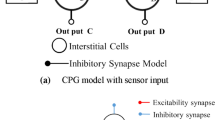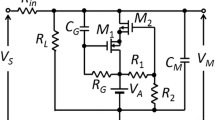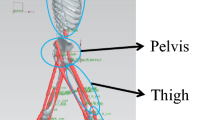Abstract
Most conventional biped robots process leg movements and information from each sensor by numerical calculation using a CPU. However, to cope with diverse environments, the numerical calculations are enormous, so they must be processed at high speed using a high-performance CPU and high power consumption. On the other hand, focusing on human motor control, it is believed that basic motor patterns such as walking and running are generated by a neural network called the central pattern generator (CPG), which is localized in the spinal cord and is independent of calculation. We previously focused on pulse-type hardware neural networks (P-HNNs), in which the neural network was composed of analog electronic circuits, and developed a hardware CPG model for controlling a single leg of a musculoskeletal humanoid robot. However, to actually move a biped robot, a CPG model that takes into account both legs and sensory information is required. Therefore, this study aims to develop a hardware CPG model for controlling both legs of a musculoskeletal humanoid robot whose gait changes according to the higher center and sensory information. We report on a hardware CPG model configured by circuit simulation confirmed the generation of walking and running patterns.





















Similar content being viewed by others
Data availability
The datasets generated and/or analyzed during the current study are available from the corresponding author on reasonable request.
References
J. Chestnutt, M. Lau, G. Cheung, J. Kuffner, J. Hodgins, and T. Kanade (2006) Footstep Planning for the Honda ASIMO Humanoid. In: Proceedings of the 2005 IEEE international conference on robotics and automation: 629–634
Guizzo E (2019) By leaps and bounds: an exclusive look at how Boston dynamics is redefining robot agility. IEEE Spectr 56(12):34–39
MacKay-Lyons M (2002) Central pattern generation of locomotion: a review of the evidence. Phys Ther 82(1):69–83
Dimitrijevic MR, Gerasimenko Y, Pinter MM (2022) Evidence for a spinal central pattern generator in humans. Ann N Y Acad Sci 860(1):360–376
Nassour J, Hénaff P, Benouezdou F, Cheng G (2014) Multi-layered multi-pattern CPG for adaptive locomotion of humanoid robots. Biol Cybern 108:291–303
Yao C, Liu C, Xia L, Liu M, Chen Q (2022) Humanoid adaptive locomotion control through a bioinspired CPG-based controller. Robotica 40(3):762–779
Someya K, Shinozaki H, Sekine Y (1999) Pulse-type hardware chaotic neuron model and its bifurcation phenomena. Neural Netw 12(1):153–161
Takeda K, Hayakawa M, Ishibashi M, Ishihara M, Ishihama T, Aibara M, Kaneko M, Uchikoba F (2022) The walking and running control of a human musculoskeletal model using a low-power consumption hardware central pattern generator model. Int J Adv Robot Syst: 1–10
Takeda K, Ishibashi M, Ishihama T, Aibara M, Kaneko M, Uchikoba F (2023) Generation and switching of human gait control signals by hardware CPG model mimicking the brainstem spinal projection system. IEEJ Trans Electron Inform Syst 143(1):13–23
Takakusaki K (2017) Functional neuroanatomy for posture and gait control. J Movement Disorders: 1–17
Takakusaki K, Chiba R, Nozu T, Okumura T (2016) Brainstem control of locomotion and muscle tone with special reference to the role of the mesopontine tegmentum and medullary reticulospinal systems. J Neural Transm 123:695–729
Kiehn O (2006) Locomotor circuits in the mammalian spinal cord. Annu Rev Neurosci 29:279–306
McMahon TA (1985) The role of compliance in mammalian running gaits. J Exp Biol 115(1):263–282
Grillner S, Rossignol S (1978) On the initiation of the swing phase of locomotion in chronic spinal cats. Brain Res 146:269–277
N. Bernstein (1966) The co-ordination and regulation of movements. The co-ordination and regulation of movements
Ivanenko YP, Poppele RE, Lacquaniti F (2004) Five basic muscle activation patterns account for muscle activity during human locomotion. J Physiol 556(Pt 1):267–282
Cappellini G, Ivanenko YP, Poppele RE, Lacquaniti F (2006) Motor patterns in human walking and running. J Neurophysiol 95(6):3426–3437
Ivanenko YP, Poppele RE, Lacquaniti F (2006) Motor Control Programs and Walking. Neuroscientist 12(4):339–348
Ivanenko YP, Cappellini G, Poppele RE, Lacquaniti F (2008) Spatiotemporal organization of a-motoneuron activity in the human spinal cord during different gaits and gait transitions. Eur J Neurosci 27:3351–3368
Morishita K, Kato S, Takei Y, Saito K (2022) Development of Receptor Cell Model with Oscillation Frequency-Dependent on Sensor Input Intensity”, IEEJ Transactions on Electronics. Information and Systems 142(1):33–39
Shik ML, Severin FV, Orlovskiĭ GN (1966) Control of walking and running by means of electric stimulation of the midbrain. 11(4): 659-666
Caggiano V, Leiras R, Goñi-Erro H, Masini D, Bellardita C, Bouvier J, Caldeira V, Fisone G, Kiehn O (2018) Midbrain circuits that set locomotor speed and gait selection. Nature: 455–460
Acknowledgements
This study was supported in part by JSPS KAKENHI, Grant-in-Aid for Scientific Research JP22K04016. In addition, this work was partially supported by the research grant of Nihon University and NUROS.
Author information
Authors and Affiliations
Corresponding author
Additional information
Publisher's Note
Springer Nature remains neutral with regard to jurisdictional claims in published maps and institutional affiliations.
This work was submitted and accepted for the Journal Track of the joint symposium of the 29th International Symposium on Artificial Life and Robotics, the 9th International Symposium on BioComplexity, and the 7th International Symposium on Swarm Behavior and Bio-Inspired Robotics (Beppu, Oita and Online, January 24–26, 2024).
About this article
Cite this article
Goto, T., Okamoto, R., Ishihama, T. et al. Development of a hardware CPG model for controlling both legs of a musculoskeletal humanoid robot with gait and gait cycle change by higher center and sensory information. Artif Life Robotics (2024). https://doi.org/10.1007/s10015-024-00939-6
Received:
Accepted:
Published:
DOI: https://doi.org/10.1007/s10015-024-00939-6




